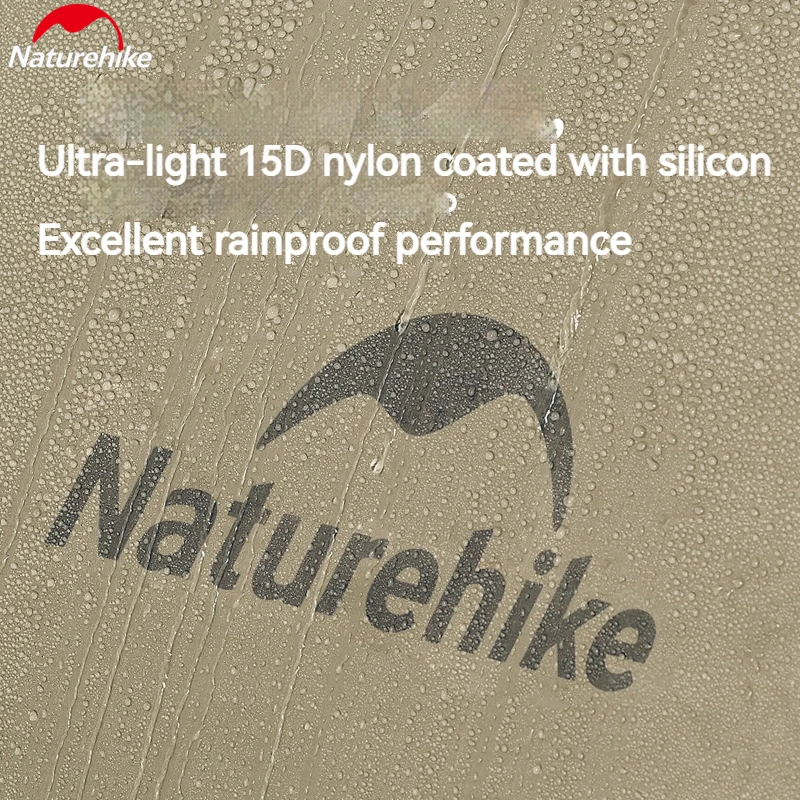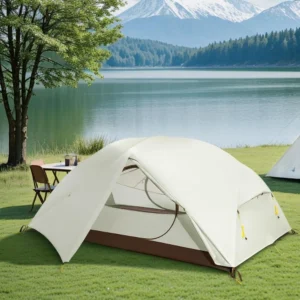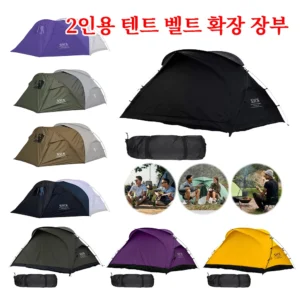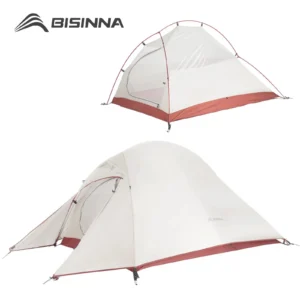1. Understanding the Multi-Season Tent Challenge
When venturing into the great outdoors, Mother Nature doesn’t always cooperate with your plans. One day might bring warm sunshine, while the next delivers pelting rain or even snow. This unpredictability creates a significant challenge for campers and backpackers who need reliable shelter regardless of conditions.
Multi-season tents offer a versatile solution to this problem, providing adaptable protection against variable weather. Rather than purchasing separate shelters for different seasons and conditions, investing in a quality multi-season tent can offer year-round reliability and protection.
The challenge lies in finding the perfect balance between:
– Weather resistance for harsh conditions
– Ventilation for warmer temperatures
– Durability for long-term use
– Reasonable weight and packability
In popular camping destinations like the Rocky Mountains or Pacific Northwest, temperatures can fluctuate by 30°F in a single day, with precipitation patterns changing rapidly. Having equipment that can handle these variations isn’t just about comfort—it’s about safety.
Throughout this guide, we’ll explore the features that make durable tents all seasons effective, compare different options, and provide recommendations to help you find the perfect shelter for your variable climate adventures.
2. Defining Key Terms: Multi-Season and Variable Climate Tents
Understanding “Variable Climate” in Camping Contexts
When we talk about variable climates in camping, we’re referring to environments where conditions can change dramatically—from sunny and mild to stormy and cold, potentially within the same trip. These conditions typically include:
- Temperature swings (from below freezing to warm)
- Various precipitation types (rain, snow, sleet)
- Wind conditions ranging from gentle breezes to powerful gusts
- Humidity fluctuations affecting comfort and condensation
The Season Rating System Explained
Tent season ratings provide a framework for understanding a shelter’s intended use and capabilities:
3-Season Tents: Designed for spring, summer, and fall use. These lightweight options feature ample mesh for ventilation and can handle light snow and moderate rain but aren’t built for harsh winter conditions.
3+ Season (Extended Season) Tents: A hybrid category offering more durability and weather resistance than standard 3-season models, with fewer mesh panels and stronger pole structures, but not as robust as full 4-season options.
4-Season (Mountaineering) Tents: Built for extreme conditions including heavy snow, strong winds, and severe storms. These tents prioritize structural strength and weather protection over ventilation and weight savings.
Understanding these distinctions helps identify the sweet spot for maximum versatility—typically found in extended-season tents or lighter 4-season designs that incorporate adaptable features like convertible ventilation systems.
The comprehensive breakdown of four-season tent features benefits reveals why certain designs excel in specific conditions. For those ready to explore options, our collection of 4-season winter 2-person tents showcases versatile designs engineered for variable conditions.
3. Anatomy of a True Multi-Season Tent: Essential Features
The effectiveness of a multi-season tent in variable climates depends on several critical design elements working together to create a balanced shelter system.
Pole Structure and Materials
The foundation of any tent’s stability lies in its pole structure:
- Material Quality: Premium tents use aerospace-grade aluminum alloys like DAC or Easton, providing superior strength-to-weight ratios compared to fiberglass.
- Configuration Design: Geodesic and semi-geodesic designs with crossing poles create stable structures that resist wind from multiple directions.
- Connection Systems: Hub-based pole systems create rigid frames that stand up to heavy snow loads and strong winds.
- Pole Diameter: Thicker poles (9-10mm vs. standard 8.5mm) significantly increase strength but add weight.
Weatherproof Fabrics
The tent’s skin provides your barrier against the elements:
- Denier Rating: This measures fabric thickness—higher numbers indicate greater durability. Variable climate tents typically use 50-70D floors and 30-40D rainflies.
- Waterproof Ratings: Measured in millimeters (mm) of hydrostatic head (HH), indicating how much water pressure the fabric can withstand before leaking. Look for at least 1500mm for rainflies and 3000mm for floors.
- Fabric Technology: Silicone-coated nylon (silnylon) and polyurethane (PU) coatings provide different advantages in waterproofing and durability.
Weather Protection Elements
- Full-Coverage Rainfly: Extends close to the ground to prevent wind-driven rain from entering.
- Vestibules: Provide protected storage space for gear and transitional areas that keep precipitation out of the main tent body.
- Strategic Seam Placement: Minimizes exposure to direct rain and includes factory-sealed or taped seams.
- Snow Skirts/Valances: On winter-capable models, these prevent drifting snow from entering.
Ventilation Systems
Proper airflow prevents condensation while maintaining comfort:
- Adjustable Vents: Allow fine-tuning based on conditions—more open in mild weather, partially closed during storms.
- Strategic Placement: High/low venting creates natural convection circulation, pulling cool air in from below and releasing warm, moist air from above.
- Mesh Panels: Provide maximum airflow in warm conditions while keeping insects out.
Understanding these all-season tent materials guide elements helps evaluate which features matter most for your specific needs. Each component represents a potential compromise between protection, weight, and versatility.
4. Pole Systems and Tent Stability: The Structural Foundation
The pole system forms the backbone of any multi-season tent’s performance in challenging conditions. Different configurations offer varying advantages for stability and weather resistance.
Pole Configurations and Their Stability Characteristics
- Dome Design: The classic curved pole structure providing good stability in moderate conditions with reasonable headroom.
- Geodesic/Semi-Geodesic: Features multiple pole crossings that distribute stress, creating exceptional stability in high winds and under snow loads.
- Tunnel Design: Excellent space-to-weight ratio but requires proper orientation to wind direction and adequate guying out.
- Hub-Based Systems: Creates rigid junctions where poles meet, enhancing overall strength and simplifying setup.
Wind tunnel tests have shown that properly designed geodesic tents can withstand winds exceeding 60 mph, while similarly sized dome tents may become unstable at 35-40 mph.
Materials Comparison
| Pole Material | Strength | Weight | Durability | Cost |
|---|---|---|---|---|
| Aluminum (7000 series) | High | Moderate | Good | Moderate |
| Carbon Fiber | Very High | Very Light | Fair (can be brittle) | Very High |
| Composite (Easton Syclone) | Very High | Light | Excellent | High |
Carbon fiber offers impressive strength-to-weight benefits but can catastrophically fail under extreme stress, while quality aluminum poles tend to bend rather than break, allowing for field repairs.
Snow Load Capacity and Wind Resistance
The architecture of pole crossings directly impacts a tent’s ability to handle snow accumulation. More crossing points create triangulated structures that prevent deformation under weight. External guy points further enhance stability by:
- Preventing pole flexing during gusts
- Distributing wind forces across the structure
- Creating secondary support systems
Heavy duty 4-season tents incorporate these advanced pole systems to deliver maximum stability when facing challenging alpine conditions or unexpected storms.
5. Weatherproof Fabrics: Finding the Right Balance
The fabric used in multi-season tents plays a crucial role in balancing protection, durability, and weight. Understanding these materials helps you evaluate what best suits your variable climate needs.
Fabric Types and Their Properties
Nylon vs. Polyester:
– Nylon: Stronger and more abrasion-resistant, but absorbs water and can sag when wet
– Polyester: Maintains tension when wet, offers better UV resistance, but typically less tear strength
– Ripstop Variants: Feature reinforcement threads that prevent tears from spreading
Waterproofing Technologies
Different waterproofing approaches offer varying performance characteristics:
- Polyurethane (PU) Coating: The standard approach, applying layers of waterproof material to the fabric’s inside face. Moderately durable and cost-effective.
- Silicone Coating: Applied to both sides (silnylon) or outside face of the fabric, offering superior water repellency and extended lifespan but at a higher cost.
- Durable Water Repellent (DWR): Surface treatment causing water to bead up and roll off, enhancing the primary waterproofing system.
Understanding Waterproof Ratings
Hydrostatic head (HH) ratings measure water resistance in millimeters:
– 1,500mm: Minimum for light rain protection
– 3,000-5,000mm: Standard for reliable rainfly performance
– 5,000-10,000mm: Heavy-duty protection for sustained harsh conditions
– 10,000mm+: Expedition-grade protection for extreme environments
A 3,000mm rated tent can withstand moderate rainfall, but during sustained storms with wind-driven rain, higher ratings provide greater security. Most quality multi-season tents feature rainflies rated at 3,000-5,000mm and floors at 5,000-10,000mm.
Denier and Durability Considerations
Fabric thickness, measured in denier (D), directly affects durability and weight:
– 15-20D: Ultralight but requires careful use
– 30-40D: Standard for rainflies, balancing weight and durability
– 50-70D: Heavy-duty floor materials for long-term durability
– 70D+: Expedition-grade materials for extreme conditions
The weather resistance durability camping tents relationship shows why higher denier materials significantly extend tent lifespan but carry weight penalties that matter on long backpacking trips.
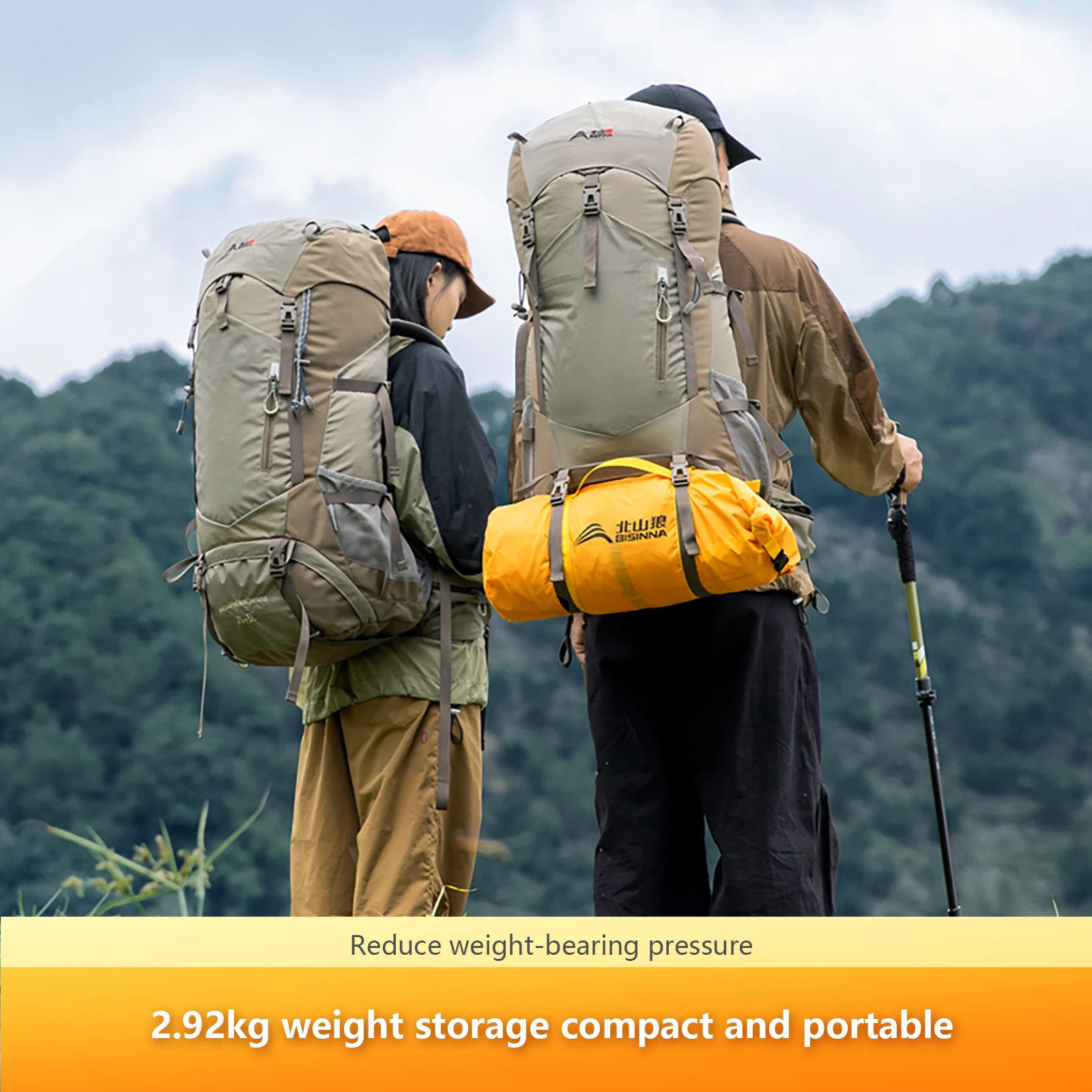
6. Ventilation Systems: Managing Condensation in All Conditions
One of the greatest challenges for multi-season tents is managing moisture from breath, body vapor, and wet gear. Effective ventilation systems make the difference between waking up dry or dealing with indoor “rain.”
The Condensation Challenge
When warm, moist air (from breathing or evaporating body moisture) contacts cold tent surfaces, it forms condensation. This problem becomes particularly acute in variable climates where:
– Temperature differentials between inside and outside are significant
– Humidity levels fluctuate dramatically
– Users need to close up tents for weather protection
A single camper produces about 1 pint of moisture through respiration and perspiration overnight—making proper ventilation essential, not optional.
Double-Wall vs. Single-Wall Construction
Double-Wall Construction:
– Creates an insulating air gap between inner tent and rainfly
– Allows moisture to escape through breathable inner tent before contacting the waterproof fly
– Offers versatility by allowing fly removal in dry conditions
– Provides better temperature regulation across varying conditions
Single-Wall Construction:
– Lighter and faster to set up
– Uses advanced waterproof-breathable fabrics
– Generally less effective at condensation management
– Better suited for consistently cold, dry conditions than variable climates
Strategic Vent Placement
The positioning of ventilation features significantly impacts their effectiveness:
– High Vents: Allow rising warm, moist air to escape
– Low Vents: Create intake points for circulation
– Cross-Ventilation: Multiple vents on opposite sides create airflow paths
– Adjustable Systems: Allow users to fine-tune openings based on conditions
Advanced designs found in quality winter camping tents incorporate adjustable ventilation systems that can be reconfigured based on conditions—fully open during milder weather and partially closed during storms while maintaining essential airflow.
7. Comparing Tent Categories for Variable Climates
When seeking the ideal tent for unpredictable weather, understanding the strengths and limitations of each category helps identify the best match for your specific needs.
Side-by-Side Comparison
| Feature | 3-Season | Extended Season (3+) | 4-Season |
|---|---|---|---|
| Wind Resistance | Moderate | Good | Excellent |
| Snow Load Capacity | Minimal | Moderate | High |
| Rain Protection | Good | Very Good | Excellent |
| Ventilation | Excellent | Good | Fair |
| Weight | Light (3-5 lbs) | Moderate (4-7 lbs) | Heavy (6-10 lbs) |
| Packed Size | Compact | Moderate | Bulky |
| Warm Weather Comfort | Excellent | Good | Poor-Moderate |
| Setup Complexity | Simple | Moderate | Complex |
| Typical Cost | $200-400 | $350-550 | $500-1000+ |
Scenarios and Optimal Choices
3-Season Tents Excel In:
– Mild spring through fall conditions
– Occasional light rain and wind
– Prioritizing weight savings and ventilation
– Regions with predictable, moderate weather patterns
Extended-Season (3+) Tents Excel In:
– Shoulder season camping (early spring, late fall)
– Moderate snowfall (up to a few inches)
– Varied conditions during a single trip
– Mixed weather regions like mountain valleys and coastal areas
4-Season Tents Excel In:
– Winter camping with significant snow
– High-altitude environments
– Exposed terrain with strong winds
– Extreme storm conditions
The sweet spot for most variable climate campers typically lies in the extended-season category, which offers significant weather protection without the weight penalties and ventilation limitations of full 4-season models. However, those regularly facing serious winter conditions or alpine environments should consider specialized compact winter tents alpine hiking designs that emphasize structural integrity.
8. Top Recommendations: Best Multi-Season Tents for Variable Climates
After analyzing dozens of tents across multiple categories, we’ve identified standout performers that deliver exceptional versatility for unpredictable weather conditions.
Evaluation Criteria
Each recommended tent was assessed based on:
– Weather protection across multiple conditions
– Structural stability in wind and under snow load
– Ventilation adaptability
– Materials quality and durability
– Weight-to-performance ratio
– Value for investment
Best Overall Versatile Performers
These tents excel across the widest range of conditions, offering the ideal balance of protection, adaptability, and livability:
Premium Choice:
– Features dome-geodesic hybrid design with 5-pole structure
– 40D ripstop nylon fly with 5000mm waterproofing
– Multiple adjustable vents with mesh and solid panels
– Full-coverage rainfly with two vestibules
– Weight: 5.5 lbs (2.5 kg)
– Best for: Maximum versatility across all non-extreme conditions
Value Option:
– Semi-geodesic design with reinforced pole structure
– 68D polyester fly with 3000mm waterproofing
– High/low ventilation system
– Full-coverage fly with single large vestibule
– Weight: 6.2 lbs (2.8 kg)
– Best for: Budget-conscious campers needing reliable all-season performance
Best Lightweight Options for Backpacking
These selections maintain impressive weather versatility while minimizing pack weight:
- Hybrid single/double wall construction with strategic reinforcement
- 20D nylon fly with silicone coating (4000mm waterproofing)
- Adjustable ventilation ports and partial mesh body
- Weight: 3.8 lbs (1.7 kg)
- Best for: Backcountry travelers who need versatility without weight penalty
Most Durable Options for Harsh Conditions
For those facing the most challenging weather scenarios:
- Full geodesic design with 5-point pole crossings
- 70D nylon fly with 8000mm waterproofing
- Reinforced guy-out points and snow valances
- Adjustable ventilation system that operates while fully battened down
- Weight: 8.5 lbs (3.9 kg)
- Best for: Alpine expeditions and winter camping
Our mountaineering tent collection features options specifically engineered for these harshest variable conditions, with designs tested in extreme environments worldwide.
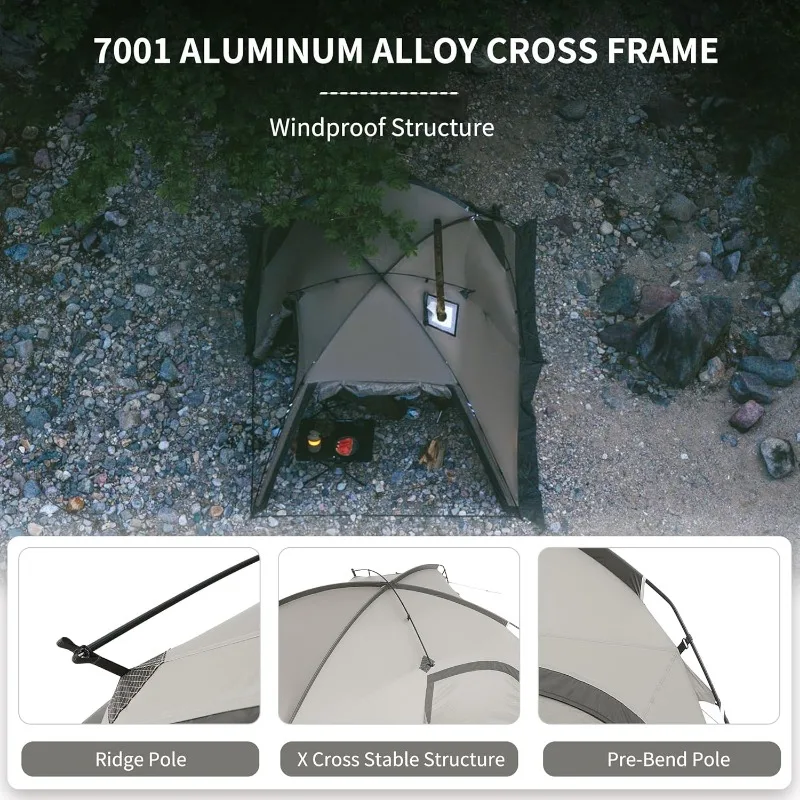
9. Buying Guide: How to Choose Your Ideal Multi-Season Tent
Selecting the right multi-season tent requires matching your specific needs with the appropriate features. This framework will help guide your decision.
Self-Assessment Questions
Start by honestly evaluating your requirements:
What are the most extreme conditions you’ll realistically encounter?
– Worst expected winds (moderate breeze vs. strong gales)
– Maximum anticipated snowfall
– Temperature ranges (mild fluctuations vs. extreme swings)How will you transport the tent?
– Backpacking (weight critical)
– Car camping (weight less important)
– Mixed use (need balanced approach)How many people need shelter?
– Solo or duo (smaller footprint options)
– Group (capacity and vestibule considerations)What’s your camping style?
– Minimalist (basic shelter)
– Comfort-oriented (space for extended stays)
– Base camp setup (durability over portability)
Feature Prioritization Framework
With your needs identified, prioritize features accordingly:
For Predominantly Cold Weather:
– Strong pole structure
– Full-coverage rainfly
– Snow-shedding design
– Minimal mesh
For Mixed Conditions:
– Adaptable ventilation
– Convertible features
– Balance of strength and weight
– Extended vestibule space for gear transition
For Weight Consciousness:
– Strategic material selection
– Simplified pole structure
– Hybrid wall construction
– Minimalist accessories
For Maximum Durability:
– Higher denier fabrics
– Reinforced stress points
– Replaceable components
– Proven track record in extreme conditions
Making an informed decision about best all-season tent performance durability value requires balancing these priorities against your budget. Remember that the most expensive option isn’t always necessary—matching features to your specific needs yields the best value.
10. Care and Maintenance for Long-Term Performance
Proper maintenance significantly extends the life of your multi-season tent and ensures it performs as designed in challenging conditions.
Setup Best Practices
Site Selection:
– Choose level ground free of sharp objects
– Consider natural windbreaks when available
– Avoid depressions where water might pool
– Position tent to minimize wind exposure (narrow end facing prevailing wind)Proper Staking:
– Use appropriate stakes for the ground conditions
– Insert at 45° angle away from tent for maximum hold
– Ensure even tension across all attachment pointsGuy Line Usage:
– Always use guy lines in windy conditions
– Attach to all available guy points during storms
– Maintain even tension to distribute forces
Cleaning and Drying Protocol
Field Cleaning:
– Brush off dirt before packing when possible
– Shake out debris daily during extended tripsHome Cleaning:
– Set up completely and brush/vacuum interior
– Spot clean with mild soap and cold water
– Never machine wash or dry clean
– Rinse thoroughly to remove all soap residueComplete Drying:
– Allow to fully dry before storage (24+ hours)
– Pay special attention to corners and seams
– Ensure poles and stakes are dry to prevent corrosion
Storage Recommendations
Loose Storage:
– Store loosely packed in large cotton or mesh bag
– Avoid compression that can damage waterproof coatings
– Keep in cool, dry location away from direct sunlightRegular Inspection:
– Check for developing issues before each season
– Look for delamination, seam separation, or zipper problems
– Test waterproofing on rainfly periodically
Following these procedures can extend a quality tent’s lifespan from 5 years to 10+ years, making your investment in best insulated tents cold weather much more economical over time.
11. Are Multi-Season Tents Worth the Investment?
Cost-Benefit Analysis: Multi-Season vs. Specialized Tents
When evaluating the investment in a versatile shelter, consider these comparative factors:
Financial Considerations:
– A quality multi-season tent typically costs $350-600
– Comparable specialized tents (separate summer and winter models) would total $500-900+
– Storage requirements double with multiple tents
– Transportation logistics become more complex
Performance Trade-offs:
– Multi-season tents deliver 85-90% of the performance of specialized models in most conditions
– Specialized tents excel in extreme scenarios but underperform outside their design conditions
– The versatility advantage allows spontaneous trips regardless of weather changes
Best-Value Scenarios
Multi-season tents provide maximum value when:
1. You camp across multiple seasons but not in extreme winter conditions
2. Your trips feature unpredictable or variable weather
3. Storage space is limited
4. You prefer mastering one shelter system rather than multiple
5. Spontaneous trips are common in your lifestyle
When Specialized Might Be Better
Consider specialized tents when:
1. You exclusively camp in very consistent conditions
2. You frequently encounter truly extreme environments (high alpine, arctic)
3. Storage and transport of multiple shelters isn’t problematic
4. Weight is absolutely critical for your specific activities
5. Budget allows for multiple high-quality shelters
Most recreational campers find that quality multi-season options like those featured in navigating nature fury durable tents provide the optimal balance of performance and value, especially as climate variability increases across traditional camping seasons.
Lightweight Backpacking Tent, Ultralight Backpacking Tent, Waterproof Backpacking Tent
$391.05 Select options This product has multiple variants. The options may be chosen on the product pageHeavy Duty 4 Season Tent, Mountaineering Tent, Winter Camping Tent
$870.40 Select options This product has multiple variants. The options may be chosen on the product pageUltralight Backpacking Tent, Ultralight Dome Tent, Winter Camping Tent
Price range: $369.63 through $370.07 Select options This product has multiple variants. The options may be chosen on the product pageHeavy Duty 4 Season Tent, Ultralight Freestanding Tent, Winter Camping Tent
$3,722.66 Select options This product has multiple variants. The options may be chosen on the product pageBackpacking Tent with Vestibule, Trekking Pole Backpacking Tent, Waterproof Camping Tent
Price range: $271.99 through $519.52 Select options This product has multiple variants. The options may be chosen on the product pageLightweight Backpacking Tent, Trekking Pole Backpacking Tent, Ultralight Backpacking Tent
$459.47 Select options This product has multiple variants. The options may be chosen on the product page
12. Advanced Weather Protection Strategies for Variable Conditions
Beyond the tent itself, experienced campers employ additional techniques to enhance protection in challenging conditions.
Strategic Site Selection
Your tent location can dramatically impact its weather resistance:
– Wind Protection: Position natural barriers (trees, rocks, terrain features) between your tent and prevailing winds
– Water Management: Select slightly elevated ground to prevent runoff issues
– Snow Considerations: Avoid areas prone to avalanche or excessive drifting
– Emergency Access: Consider accessibility if conditions deteriorate rapidly
A properly positioned tent in a less-than-ideal location often performs better than a poorly positioned premium shelter.
Supplementary Protection Systems
Enhance your tent’s capabilities with these proven techniques:
– Tarp Shields: Set up windward tarps to break gusts before they hit your tent
– Snow Walls: In winter conditions, build snow windbreaks around exposed sides
– Drainage Trenches: During heavy rain, small channels can divert water flow (follow Leave No Trace principles)
– Internal Guy Lines: Add internal guy lines for additional support during heavy snow loading
Advanced Setup Techniques for Specific Conditions
For High Wind:
– Use all guy points with non-stretching cord
– Double-stake critical anchors
– Position lowest profile toward wind
– Reduce internal height by lowering adjustable poles
For Heavy Rain:
– Ensure complete rainfly tension to prevent contact with inner tent
– Angle doors away from prevailing wind
– Establish clear drip lines from vestibules
– Consider supplementary ground cloth extension at entrance
For Snow Loading:
– Regularly clear accumulation before weight becomes significant
– Set up in dome configuration rather than more vertical orientations
– Use crossing poles at maximum tension
– Consider internal support poles for extreme conditions
These techniques complement the design features found in waterproof backpacking tents, allowing them to perform beyond their rated capabilities when necessary.
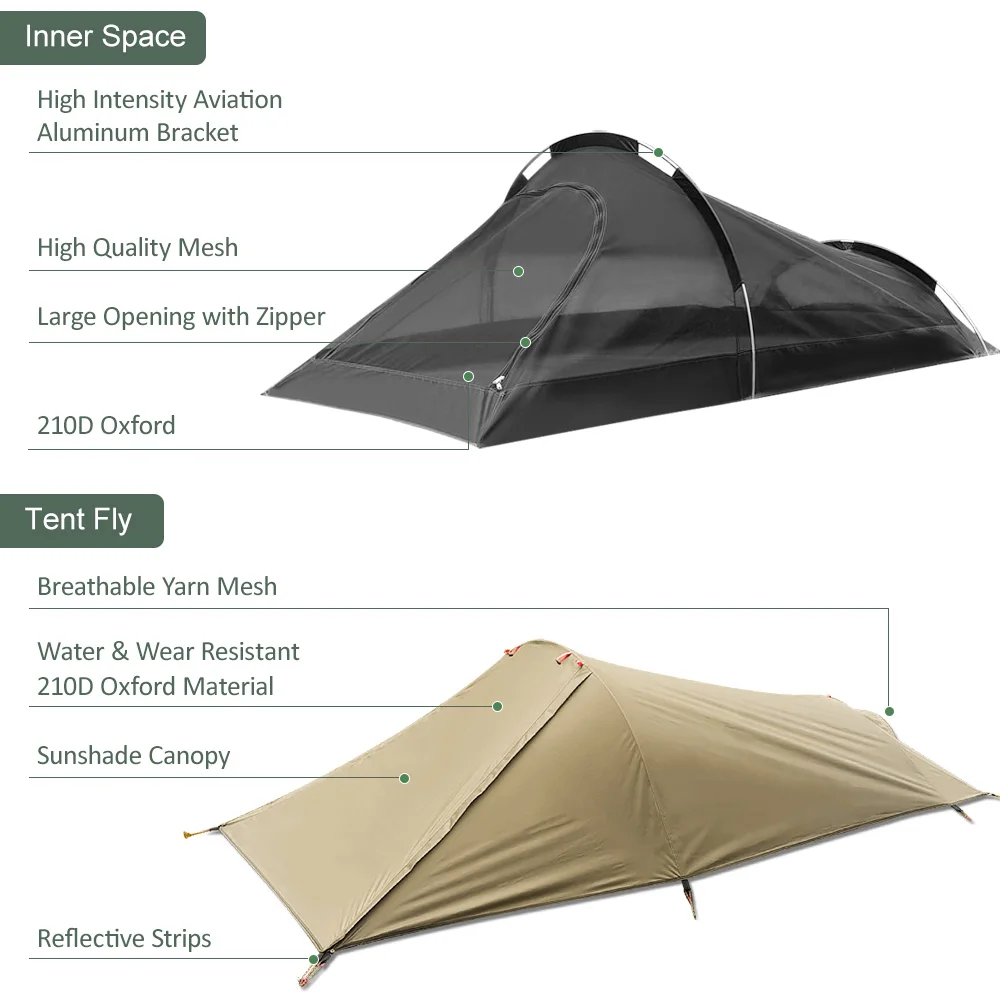
13. Common Multi-Season Tent Problems and Solutions
Even the best multi-season tents face challenges in variable conditions. Here are practical solutions to the most common issues.
Excessive Condensation Management
Problem: Moisture buildup on tent interior, particularly in transitional seasons.
Solutions:
– Increase ventilation by opening vents even in cooler weather
– Position tent to capture prevailing breezes
– Avoid setting up near water sources when possible
– Use a small camp towel to wipe down interior walls in the morning
– Keep wet gear in vestibules rather than tent interior
– Leave rainfly doors partially open when weather permits
Cold Spots and Draft Prevention
Problem: Uneven temperatures and uncomfortable air movement inside the tent.
Solutions:
– Identify and seal gaps where cold air enters (usually door zippers and floor edges)
– Use gear strategically as draft barriers along tent perimeter
– Ensure complete stake-out to maintain tent shape and insulation layer
– Add a thermal tent footprint that extends slightly beyond floor dimensions
– Position sleeping pads to cover the entire floor area
– Consider a tent-safe portable heater for extreme conditions
Overheating in Warm Conditions
Problem: Multi-season tents can become uncomfortable in warmer weather.
Solutions:
– Remove the rainfly when weather permits
– Set up in shaded areas
– Maximize all ventilation options
– Orient doors to capture prevailing breezes
– Use reflective sunshades above tent during daylight hours
– Consider a small portable fan for air circulation
Snow Loading Concerns
Problem: Snow accumulation causing pole stress or potential collapse.
Solutions:
– Select tent with steep walls and minimal flat surfaces
– Regularly clear snow before significant accumulation
– Reinforce critical pole sections with repair sleeves before heavy snow
– Add internal guy lines to support potential stress points
– Consider aftermarket pole upgrades for winter-priority use
Proactive measures like those discussed in mastering tent insulation year-round camping can prevent many of these issues before they become serious problems, especially during dramatic weather transitions.
14. Frequently Asked Questions About Multi-Season Tents
Can I use a 4-season tent year-round?
Yes, but with limitations. While 4-season tents excel in cold and harsh conditions, they typically have fewer mesh panels and ventilation options, making them stuffy and uncomfortable in warmer weather. They’re also heavier to carry. Extended-season (3+) tents often provide better year-round versatility unless you regularly camp in truly extreme conditions.
What’s more important: waterproof rating or design?
Both work together, but design often matters more. A well-designed tent with moderate waterproofing (3000mm HH) will typically outperform a poorly designed tent with higher ratings (5000mm+). Features like proper rainfly coverage, strategic seam placement, and adequate guy points contribute significantly to real-world weather resistance.
How much should I expect to spend on a quality multi-season tent?
For genuine multi-season performance, expect to invest between $300-700 for a quality 2-person tent. Lower-priced options ($150-250) might claim multi-season capability but typically compromise on materials, construction quality, or design features critical for performance in challenging conditions.
Single-wall versus double-wall for variable climates?
Double-wall tents generally perform better in variable climates due to their superior condensation management and adaptability. The separate rainfly can be removed in dry conditions, while the inner tent’s breathable fabric helps manage moisture. Single-wall designs offer weight savings but struggle with condensation in fluctuating temperatures—a common issue in variable climates.
What’s the difference between “convertible” and “extended-season” tents?
Convertible tents feature removable or adaptable components (pole sections, fly panels, vestibules) that can be reconfigured for different seasons. Extended-season tents have fixed designs with enhanced strength and weather resistance compared to 3-season models, but less than full 4-season tents. Convertible designs offer greater adaptability but often with complexity and weight penalties.
For those interested in innovative designs that maximize versatility, trekking pole backpacking tents represent an emerging category that delivers impressive strength-to-weight ratios through smart engineering and multi-functional components.

